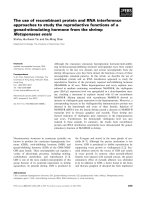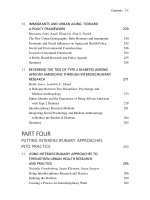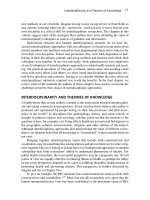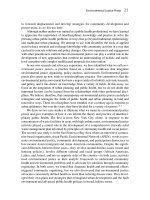Microfluidics and microarray based approaches to biological analysis 2
Bạn đang xem bản rút gọn của tài liệu. Xem và tải ngay bản đầy đủ của tài liệu tại đây (1.2 MB, 43 trang )
Chapter 2
CHAPTER 2 MICROFABRICATED DEVICES FOR NUCLEIC ACID
AMPLIFICATION AND ELECTROPHORETIC SEPARATION
2.1 Introduction
The interest in electrophoretic separations on microfabricated devices has grown
dramatically over the past few years due to the many advantages it offers. The short
plugs, good dissipation of Joule heating, and high field strengths result in extremely
rapid separations that consume only picoliter sample volumes.
2.1.1 Theory of Electrophoretic Based Separations
Electroosmotic Flow
As shown in Figure 2.1, the inner walls of fused silica capillaries possess an intrinsic
negative charge due to the presence of weakly acidic silanol groups (-SiOH) (pKa ~
5.3).
1
Cations in solution build up near the capillary surface to balance this charge,
thus forming an electrical double layer. Upon the application of an electric field across
the length of the capillary, the cations in the diffuse portion of the double layer migrate
towards the cathode. Since these cations are hydrated, they induce a bulk flow of
solution within the capillary towards the cathode. The magnitude of this electroosmotic
flow (EOF) is generally described by the Scholuchowski equation:
η
ε
ζ
µ
−=
Where ε and η are the dielectric constant and viscosity of the solvent, and
ζ
is the zeta
potential. The zeta potential is the potential slightly off the silica surface at the plane of
22
Chapter 2
shear, and is a function of the deprotonation of the silanols, ion adsorption onto the
surface and the ionic strength of the buffer.
+
_
+
+
+
+
+
+
+
+
+
+
_
_
_
N
N
N
NN
N
+
++
+
+
+
_ _
_
+
adsorbed
layer
compact
layer
diffuse layer
++
__
++
++
++
++
++
++
++
++
++
++
__
__
__
NN
NN
NN
NNNN
NN
++
++++
++
++
++
__ __
__
++
adsorbed
layer
compact
layer
diffuse layer
Figure 2.1. Schematic representation of the electrical double layer at the capillary
inner wall. Positive, negative and N signs respectively represent cations, anions, and
non-charged species.
Electrophoretic Flow
The basis for the electrophoretic process is the differential migration of sample ions
relative to solvent molecules under the influence of an externally applied electric field.
There are two main contributors to the ion mobility, the applied electric force (F
e
) and
the frictional force (F
fr
) that the molecules experiences as it moves through the buffer
solution. The applied electric force (F
e
) depends on the charge q of the particular ion
and electric field E:
F
e
= qE
The frictional force (F
fr
) depends on the viscosity of the buffer (η), the velocity of the
ion (ν, cm/s) and the size of the molecule (radius of ion, r):
F
fr
= 6πηνr
When the two forces are counterbalanced the ions move with a steady-state velocity:
ν = qE / 6πηr
23
Chapter 2
The mobility is then the electrophoretic velocity normalized to the electric field
strength:
µ = ν/E = q/6πηr
2.1.2 Electrophoretic Separations in Microfabricated Devices
2.1.2.1 General Description
The design of microchips for capillary electrophoresis has undergone significant
development from simple single-channel structures to increasingly complex ones. In
the most basic design, a microchip is formed of two intersecting channels, the injection
channel and the separation channel, as shown in Figure 1.1.
The primary means of material transport on chips are the electrokinetic phenomena,
i.e. electrophoretic and/or electroosmotic effects. Buffer and sample flows within the
channel manifold are precisely controlled through potentials applied to the reservoirs.
The intersection between the injection and separation channels has been called the
injection cross since its volume defines the sample volume injected into the separation
channel. The integrated injectors are usually either cross-channel injectors, formed by
orthogonally intersecting the separation channel with a channel connecting the sample
to waste as shown in Figure 1.1, or twin-T injectors, where the two arms of the sample
to waste channel are offset to form a larger injection region as shown in Figure 2.2.
24
Chapter 2
Separation Channel
1
3
2
4
Sample
reservoir
Buffer
reservoir
Sample
waste
Buffer
waste
Separation Channel
1
3
2
4
Sample
reservoir
Buffer
reservoir
Sample
waste
Buffer
waste
Twin-T injector
Separation Channel
1
3
2
4
Sample
reservoir
Buffer
reservoir
Sample
waste
Buffer
waste
Separation Channel
1
3
2
4
Sample
reservoir
Buffer
reservoir
Sample
waste
Buffer
waste
Twin-T injector
Figure 2.2. Schematic layout of a microchip electrophoretic device with a twin-T
injector
CE chips are mainly fabricated using various glass substrates from inexpensive soda
lime glass to high quality quartz. Glass substrates are the most common substrates
because of their good optical properties, well-understood surface characteristics, and
well-developed fabrication methods adapted from the microelectronics industry. Much
of the technology developed for the semiconductor industry can be transferred directly
to chip fabrication using insulating substrates.
2
Although slight variations in glass
fabrication techniques exist, the general fabrication aspects are similar (Figure 2.3).
Generally a positive photoresist is spin-coated on top of the substrate, and the channel
design is transferred to the substrate using a photomask. Following exposure and
development of the photoresist, the channels are etched into the substrate in a dilute
HF/NH
4
F bath. Because the photoresist used to mask wet etches does not adhere well
to glass, a sacrificial layer that adhere well to both glass and photoresist is often used
as intermediate layer (Figure 2.3). The access holes can be drilled on the etched
substrate or another blank glass wafer. To form the closed network of channels, the
cover plate is bonded to the substrate over the etched channels. Finally cylindrical
reservoirs, to hold buffers and samples, are affixed onto the extremity of the channels.
25
Chapter 2
Glass substrate
coated with
sacrificial layer
Photoresist
coated
Photoresist
exposed
Photoresist and
sacrificial layer
removed in mask
pattern
Glass etched
Photoresist and
sacrificial layer
removed
Bonded with another
piece of glass
Sacrificial layer
Photoresist
UV light
photomask
Glass substrate
coated with
sacrificial layer
Photoresist
coated
Photoresist
exposed
Photoresist and
sacrificial layer
removed in mask
pattern
Glass etched
Photoresist and
sacrificial layer
removed
Bonded with another
piece of glass
Sacrificial layer
Photoresist
UV light
photomask
Figure 2.3. Schematic diagram of the photolithographic process used for making chips
Although most microchip devices fabricated to date use glass, there have been several
reports of devices fabricated from a variety of polymeric substrates including
poly(dimethylsiloxane) (PDMS),
3
poly(methyl methacrylate) (PMMA),
4
acrylic,
5
and
polycarbonate.
6
The interest in polymeric microfluidic devices stems primarily from
the fact that plastic chips are less expensive to produce, and can be disposed after
single use.
2.1.2.2 Injection Methods
Sample injection, by default, was the first functionality integrated into single substrates
by fabricating intersecting channels at right angles. The formed cross was intended to
create a geometrically defined sample plug with a volume close to that of the
26
Chapter 2
intersection cross. Later on, various sample injection methods were developed making
use of both EOF and electrophoretic effects.
Floating Injection
For the floating injection mode, only two electrodes are used. Voltage is applied
between the sample reservoir and the sample waste reservoir (Figure 2.4, left). Buffer
and buffer waste reservoirs are left floating. Consequently, the sample solution is
pumped past the injection cross to the sample waste reservoir. If the injection potential
is applied long enough to ensure that even the slowest moving component passes
through the injection cross, the injection plug will have a composition representative of
the sample to analyze. To introduce the sample plug into the separation channel, the
potentials are switched from the sample loading to the separation mode of operation,
i.e. potential is applied between buffer reservoir and buffer waste reservoir (Figure 2.4,
right). However, since the potential in the separation channel is left floating during
injection, the analyte is free to diffuse into the separation channel. This problem is
particularly important with small ions and molecules having high diffusion
coefficients.
27
Chapter 2
Sample
reservoir
Buffer
reservoir
Buffer
waste
Sample
waste
Sample
waste
Sample
reservoir
Buffer
reservoir
Buffer
waste
Sample
reservoir
Buffer
reservoir
Buffer
waste
Sample
waste
Sample
waste
Sample
reservoir
Buffer
reservoir
Buffer
waste
Figure 2.4. Schematic of floating injection
Pinched Injection
The pinched injection is achieved by spatially confining the sample in the cross
intersection before dispensing it into the separation channel.
7,8
The sample flow
between the sample reservoir and sample waste is electrokinetically confined by the
incoming buffer streams from the buffer reservoir and buffer waste (Figure 2.5, left).
The extent of sample focusing is regulated by the electric field strength in separation
channel versus injection channel. Once the sample flow has reached a steady state, the
electric field is switched to a dispensing step serving also as the separation step (Figure
2.5, right). In this step, to prevent sample leakage into the separation channel and
achieve a short axial extent sample plug, an electric field is also applied to sample
buffer and sample waste to draw sample back from the intersection.
28
Chapter 2
Sample
reservoir
Buffer
reservoir
Sample
waste
Sample
reservoir
Buffer
waste
Sample
waste
Buffer
reservoir
Buffer
waste
Sample
reservoir
Buffer
reservoir
Sample
waste
Sample
reservoir
Buffer
waste
Sample
waste
Buffer
reservoir
Buffer
waste
Figure 2.5. Schematic of pinched injection
When the pinched and floating injections are compared, the pinched sample loading is
superior in two areas: temporal stability and plug length. The pinched sample injection
is independent of time, electrophoretic mobility, and electric field strength. On one
hand a smaller plug length leads to higher efficiency but on the other hand can be
detrimental to the sensitivity as less analyte is injected.
Gated Injection
In order to increase the amount of analyte injected into the separation channel, the
gated injection was developed.
9,10
The gated valve has a loading/separation mode
where the sample flows from sample reservoir to the sample waste while the buffer
flows from the buffer reservoir to the buffer waste to prevent sample leakage and
provide continuous buffer supply into the separation (Figure 2.6, left). To make an
injection, the field in the buffer reservoir is set to zero allowing a plug of sample to
move into the separation channel (Figure 2.6, middle). In the subsequent separation
step (Figure 2.6, right), the field is switched back to the loading/separation step. The
29
Chapter 2
buffer flow cuts the sample plug, and the injection valve returns to its original state.
The length of the injection plug is therefore a function of both the time of the injection
and the electric field strength.
Sample
reservoir
Buffer
waste
Sample
waste
Buffer
reservoir
Buffer
reservoir
Buffer
reservoir
Sample
waste
Sample
waste
Sample
reservoir
Sample
reservoir
Buffer
waste
Buffer
waste
Float
Sample
reservoir
Buffer
waste
Sample
waste
Buffer
reservoir
Buffer
reservoir
Buffer
reservoir
Sample
waste
Sample
waste
Sample
reservoir
Sample
reservoir
Buffer
waste
Buffer
waste
Float
Figure 2.6. Schematic of gated injection
The gated injection differs from the pinched injection on several counts. With the
gated injector, the sample migrates electrophoretically down the separation column and
is cleaved by restoring the flow of buffer from the buffer reservoir. The pinched
sample loading pumps the sample through the injection cross, and the plug, which is
injected onto the separation channel, is the sample which resides in the injection cross.
With the pinched sample loading, the amount loaded onto the separation column is
time independent and has no electrophoretic bias. The gated injector is both time
dependant and electrophoretically biased, but allows for injecting more analyte and is
therefore appropriate for samples of low concentrations.
30
Chapter 2
2.1.2.3 Advantages
Both electrophoretic migration of ions and electroosmotic flow velocity are linearly
dependent on the axial electric field strength applied. While in the case of pressure-
driven flow the external force is applied across the whole cross section of the tube
leading to a parabolic flow profile, in electroosmosis the external force can only be
exerted to a thin sheet of fluid close to the wall, thus leading to a plug-flow profile.
The short plugs, good dissipation of Joule heating, and high field strengths result in
extremely rapid separations that consume only picoliter sample volumes.
2.1.3 Combined Microchip Based Electrophoretic Separation and Micro
Polymerase Chain Reaction
Micro CE dramatically increases the speed of nucleic acid separation. However, prior
to separation, if present in low amounts, the nucleic acid of interest should be
amplified by Polymerase Chain Reaction (PCR) to obtain enough material for
detection. PCR has revolutionized bioscience due to its ability to exponentially and
specifically amplify DNA templates from very small starting concentrations.
Miniaturization offers improved thermal energy transfer compared to conventional
macrovolumes, resulting in a greatly increased speed of thermal cycling and reduced
amount of expensive reagents used. A PCR-CE combination reduces the
contamination problem, decreases the risk of infection, and allows for faster execution
of the analysis through reduced manual manipulations. There have been several reports
on integration of DNA amplification and electrophoretic separation on a single
microfabricated chip. These devices contain small reaction wells, which were
thermocycled to generate amplicons, followed by the injection/separation/detection
steps in the interconnected microchannel network.
31
Chapter 2
Woolley et al reported the PCR amplification of DNA in a microfabricated chamber
containing silicon heaters that could be directly interfaced with an electrophoretic chip
for PCR product analysis.
11
Oda et al reported a noncontact heating thermocycling
using inexpensive IR for rapid PCR amplification, the detection was later made by
conventional slab gel electrophoresis or CE.
12
These approaches, without a large
heating/cooling block, significantly increase the rate of thermal cycling, but the
temperature control becomes more difficult than for conventional systems. Multiplex
reactions can also be performed on-chip. By filling the sample reservoir with the PCR
mixture and cycling the whole CE chip in a conventional thermocycler, rapid
amplification was achieved and the PCR products were later analysed on the same
chip.
13
An integrated system combining fast on-chip DNA amplification by local
thermocycling followed by microchip electrophoretic sizing was reported.
14
An
interesting alternative to a microchamber reaction format has been proposed by Kopp
et al who demonstrated a continuous-flow PCR system.
15
A PCR cocktail was pumped
continuously through a serpentine glass channel, periodically passing the three
temperature zones to perform denaturation, annealing and amplification steps.
Although total reaction time was relatively long (50 min for 20 cycles), multiple
simultaneous reactions can be carried out by sequential introduction of separate
reactions in each loop. A microfabricated structure for integrated PCR amplification
and CE separation was reported by Burns et al.
16
They developed a device that used
microfabricated channels, heaters, temperature sensors and fluorescence detectors to
analyze nanoliter-size DNA samples. The device was capable of measuring aqueous
reagent and DNA containing solutions, mixing the solutions together, amplifying or
digesting the DNA to form discrete products, and separating and detecting these
products. An important aspect of the device was the ability to meter a small, accurate
32
Chapter 2
volume of fluid by means of a hydrophobic patch and injected air. More recently,
Lagally et al developed an integrated monolithic system incorporating several 280 nL
PCR chambers etched into a glass structure, connected to microfluidic valves and
hydrophobic vents for sample introduction and immobilization during thermal
cycling.
17
They used DNA sample of very low concentration and observed the
stochastic PCR amplification and analysis of single-molecule DNA templates and were
able to detect single-molecule amplification. Recently, Northup and co-workers
designed a portable system containing a miniature analytical thermal cycling
instrument in which a silicon-micromachined reaction chamber with integrated heaters
and optical windows was used to conduct PCR amplification. However, this particular
device was not interfaced with any electrophoretic separation channel, but instead
characterization of the amplified product was accomplished by real-time fluorescence
monitoring.
18
This device is especially useful for field use. Real-time PCR is in that
case especially convenient as it does not require time-consuming post PCR
manipulation and processing of the reaction with slab gel or CE, hybridization to DNA
arrays or mass spectrometry. This strategy was applied for the very rapid detection of
bacteria.
19
Efforts have been made to minimize the time needed for on-chip PCR
amplification to less than 240 seconds.
20
Polymeric chips were used, thus reflecting the
wider arrays of applications of polymeric materials to microfabricated devices. A
hybrid poly(dimethylsiloxane) (PDMS)-glass microchip for functional integration of
DNA amplification and gel electrophoresis has also been reported. Thermoelectric
heating/cooling was used in this case. Such devices can be disposable due to their
inexpensive and relatively simple fabrication. In addition to a decrease in amplification
time, there is a wide interest in trying to increase the density of reactions carried out at
33
Chapter 2
the same time and Nagai et al reported a high throughput PCR amplification in a
silicon based array.
21
2.2 Results and Discussion
2.2.1 Method Development Based on Conventional Capillary Electrophoresis
2.2.1.1 Optimization of Separation Condition with Conventional Capillary
Electrophoresis
Slab gel electrophoresis was previously the method of choice to separate PCR
amplified DNA fragments. However, slab gel electrophoresis, followed by stain or
probe detection, is often time-consuming and labor intensive. Capillary electrophoresis
(CE) is an alternative approach, which offers many advantages. Because of the high
surface-to-volume ratio, the efficiency of heat dissipation is much higher than in slab
gel electrophoresis. Thus, much higher electric fields can be applied during
electrophoresis, resulting in faster separations. CE also offers the possibility of full
automation, avoiding time-consuming pouring and loading, as well as increased
precision and the possibility to quantitate results.
The separation matrix chosen was based on entangled cellulose polymers since these
are known to provide good sieving ability allowing for easy filling of capillaries and
channels. The monointercalating fluorophore Thiazole Orange (TO) was chosen as
intercalating dye because it provided the most sensitive detection among monomeric
dyes
22,23,24
and because of its compatibility with the ion argon laser excitation line (488
nm). Using 1×TAE (89mM Tris, 89mM Acetic acid, 2mM Disodium EDTA), 0.75 %
Hydroxyethylcellulose (HEC) and 0.25 µg/mL TO, the two Z and W female bird genes
34
Chapter 2
could be baseline resolved at 12kV as shown in Figure 2.7. Similarly to the
mammalian X and Y genes, the Z and W genes are bird sex genes, but whereas
mammalian females have two X genes and males have one X and one Y gene, male
birds have two Y genes and female birds have one X and one Y gene. The Z male bird
genes appear as only one single peak because the two genes are of the same size
(Figure 2.8). The Z gene, common to the male and female, migrates faster and thus has
a smaller number of bp than the W gene present only in the female species. High
separation efficiencies of 1 × 10
6
and 8.8 × 10
5
theoretical plates per meter were
obtained for the female bird genes. The separation of the two genes depends on the
polymer concentration but an increase in the HEC concentration did not result in any
improvement in separation efficiency and resulted only in an increase in polymer
viscosity and was therefore more difficult to flush into the capillary. The use of other
cellulosic polymers was also attempted. Methylcellulose (MC) was very difficult to
solubilize and needed overnight stirring. Neither hydroxypropylmethylcellulose
(HPMC) nor MC could achieve the high separation efficiencies obtained for HEC.
Figure 2.7. Capillary electrophoretic separation of female bird genes; concentration:
10 ng/µL; buffer: 1xTAE, 0.75 % HEC, 0.25 µg/mL TO; separation voltage: 12 kV;
separation capillary: 50 µm i.d. × 70 cm total length (effective length 57 cm).
35
Chapter 2
Figure 2.8. Capillary electrophoretic separation of male bird genes (same separation
conditions as in Figure 2.7).
Some of the main advantages of capillary electrophoresis over slab gel electrophoresis
may be attributed to its high heat dissipation and shorter separation times due to the
use of higher electric fields. To reduce the migration times of the fragments, without
loss of resolution, the voltage was increased from 12 kV (170V/cm) to 20 kV
(285V/cm). This resulted in a loss of efficiencies as shown in Table 2.1. In the range
from 12 kV to 20kV, the two peaks were baseline resolved (Figure 2.9). However a
decrease in peak height was observed at higher voltages. Given that the TO
intercalating dye was present in the running buffer and that the dye would react with
the DNA as the latter migrated through the polymer, a higher voltage and consequently
shorter migration time would lead to a lower interaction time between DNA and the
dye. Consequently, lower fluorescence intensities of the DNA fragments at higher
voltages were observed. The second peak exhibited a lower fluorescence intensity
compared to the first peak, irrespective of the applied voltage. This can be explained
by a depletion phenomenon.
25
As the fragments migrated through the capillary, a
depletion of dye occurred, resulting in a lower interaction between the dye and the
DNA fragments from the first fragments to the last ones. Separation at 15 kV offered a
36
Chapter 2
relative short run time. Relative standard deviations (RSDs) of the migration times for
six successive injections are listed in Table 2.2. The separated fragments can thus be
accurately determined with high efficiencies, and limits of detection of 0.1 ng/µL were
obtained (S/N>3).
Figure 2.9. Influence of separation voltage, (a) 12 kV, (b) 15 kV, (c) 18 kV and (d) 20
kV. Other separation conditions are same as in Figure 2.1.
E (kV) N/m (10
5
)
Female Male
-12 10.0 8.8
-15 10.8 8.0
-18 8.8 7.0
-20 6.6 5.9
Table 2.1. Separation efficiencies as function of the separation voltage, with
N=5.54(t/∆t
1/2
)
2
, where t is the migration time and ∆t
1/2
is the measured full width of a
peak at half maximum.
37
Chapter 2
Female Male
Z W Z
% R.S.D. 0.38 0.38 0.52
Table 2.2. R.S.D.s for 6 consecutive runs
2.2.1.2 Influence of DNA: Dye Ratio on the Electrophoretic Separation
Simple (monomeric) intercalators such as ethidium bromide (EtBr) and TO, which
have reduced steric constraints, could potentially intercalate with a ratio of 1/1
(dye/bp). However, results from previous studies indicated a saturation maximum of
one intercalator molecule per two base pairs.
26,27
The intercalating dye is expected to
serve a dual role in the separation process. It improves the detectability of the DNA but
also acts to enhance resolution by uncoiling the DNA and improving its ability to
interact with the polymer matrix.
28
The intercalation of positively charged TO causes
longer migration times of DNA fragments as the charge of the DNA becomes less
negative.
27
TO also greatly enhances the native fluorescence of the DNA as it
intercalates in the double stranded (ds) DNA. However, TO should be mixed with the
buffer, and not with the DNA sample, because preformed complexation of ds-DNA
with dyes often results in band broadening and tailing.
27,29
In addition, DNA
precomplexed with dye will not be electrokinetically injected as effectively as
unstained DNA since the negatively charged fragments are partially neutralized by the
cationic dyes.
23
Using {1-(4-[3-methyl-2,3-dihydro-(benzo-1,3-oxazole)-2-
methyidene]-quinolinium)-3-trimethyl ammonium propane diiode} (YO-PRO-1) as
dye, McCord et al. observed that the dye: DNA ratio does not have much influence on
separation efficiency. On the contrary, when using TO, the dye: DNA ratio is of
38
Chapter 2
critical importance.
27
Increasing the TO concentration from 0.25 to 1 µg/mL resulted
in broad peaks (Figure 2.10) and relatively low peak heights as previously observed.
Figure 2.10. Influence of increasing TO concentration on separation efficiency;
sample concentration: 10 ng/µL, buffer: 1xTAE, 0.75 % HEC, 12 kV, 0.25 µg/mL TO;
separation voltage: 12 kV; separation capillary: 50 µm i.d. × 70 cm total length
(effective length 57 cm).
2.2.1.3 Determination of Fragment Size
In order to determine the size of the analyzed fragments, the same buffer and
separation conditions were applied when separating the 25 bp ladder. The separation at
15 kV, with efficiencies ranging from 1 to 1.9 × 10
6
theoretical plate numbers, is
shown in Figure 2.11. The Ogston model
30,31
has been used to describe the mobilities
of DNA fragments of low numbers of bp in polymer solutions. The mobility µ varies
with the size of the DNA molecule: µ=µ
0
e
-KCN
, where µ
0
is the mobility of DNA in
free solution, K is a constant and N is the number of bp of the DNA fragment. Using
the data obtained with the 25 bp ladder, we plotted µ=f(N) as shown in Figure 2.12.
This model can satisfactorily describe the mobilities of fragments of sizes ranging
from 25 to the usual value of N=250
32
, with a correlation coefficient of 0.9978. For
fragments with a larger number of base pairs, the reptation model has been
developed.
33,34,35
In that case, the DNA fragments move “snake-like” through the pores
39
Chapter 2
of the polymer, and the mobilities are inversely proportional to the sizes of the DNA
fragments: µ≈N
-1
. By plotting the mobilities as a function of 1/N for the fragments
with sizes ranging from 275 to 500 bp, a straight line was obtained (Figure 2.13) with a
correlation coefficient of 0.9938. Using this latter graph we could determine the sizes
of the two bird sexing genes Z and W, which respectively contained 350 and 368 base
pairs.
Figure 2.11. Capillary electrophoretic separation of 25 bp ladder (10 ng/µL); , buffer:
1xTAE, 0.75 % HEC, 0.25 µg/mL TO; separation voltage: 12 kV; separation capillary:
50 µm i.d. × 70 cm total length (effective length 57 cm).
Ln(u)
-6.3
-6.25
-6.2
-6.15
-6.1
-6.05
-6
-5.95
0 50 100 150 200 250
N
Figure 2.12. Ln(µ) as function of the number of base pairs (N).
40
Chapter 2
1.55
1.6
1.65
1.7
1.75
1.8
1.85
1.9
1.9 2.1 2.3 2.5 2.7 2.9 3.1 3.3 3.5 3.7 3.9
1/N (*10E3
)
u (*10E4cm2V-
1s-1)
Figure 2.13. Mobility µ as function of the inverse of the number of base pairs (1/N).
2.2.1.4 Capillary Coatings
A chemical gel consists of a sieving matrix such as polyacrylamide, which is cross-
linked and/or chemically linked to the capillary wall, or channel wall. The gel is
prepared in the same manner as slab gels. In CE and micro CE, the solution is pumped
into the capillary/channel where it polymerizes in situ. The media is permanently
“fixed” in the capillary. When the gel is no longer functional, neither is the capillary,
nor the microchip. Hence, some physical gels have been developed. These are, in the
simplest terms, “viscous buffers”; solutions of hydrophilic polymers dissolved in an
appropriate buffer. The attractive characteristic of physical gels is that the polymers
used are not cross-linked and therefore, they can be pumped out of the capillary at the
end of each run, the most important of these polymers being hydroxyethyl cellulose,
linear polyacrylamide (PA), and polyethylene oxide. The disadvantage of using PA is
that it must be used at a somewhat higher viscosity than some of the other polymers,
and the monomers used in its manufacture are toxic. Hence cellulose-based polymers
were used throughout this work. The most important prerequisite for the use of a gel in
41
Chapter 2
a capillary is the complete elimination of the electroosmotic flow (EOF). If this
condition is not adequately fulfilled, the gel is extruded out of the capillary by the EOF
and separation becomes impossible. The first widely used method, to date, for the
functionalization of such capillaries was first described by Hjerten (Figure 2.14).
36
Si
O
Si
SiOH
SiO
-
K
+
KOH
SiOH
SiOH
HCl
SiOH
SiOH
(MeO)
3
Si
(CH
2
)
3
O
CH
3
CH
2
+
Si
(CH
2
)
3
O
CH
3
CH
2
Si
Si
O
O
OMe
TEMED,
Persulfate
Si
(CH
2
)
3
O
CONH
2
CH
2
Si
Si
O
O
OMe
CH
CCH
2
CH
3
CH
2
CH
CONH
2
CH
2
CH3
CONH
2
Figure 2.14. Reaction scheme for coating of the capillary wall
The functionalisation of capillaries and channels, using this strategy, is straightforward
and gives reproducible results. However, the coating procedure can be lengthy and the
coating is not stable at a high or low pH. In addition, it involves the use of toxic
chemicals such as acrylamide, which is detrimental when working with microchips and
a dynamic capillary coating was therefore investigated and compared with a permanent
coating.
Polyvinylpyrrolidone (PVP) has self-coating properties to the silica wall, reducing the
EOF values significantly,
37
as well as sieving properties for DNA sizing separations.
38
The main advantage of dynamic coatings such as PVP is the simplicity of preparation
42
Chapter 2
and regeneration of the surface between runs. This can be easily realized since coating
is achieved by just flushing the buffer through the channels. It presents obvious
advantages for chip-based separations since no permanent coating of the chip has to be
performed, and PVP coating was compared to PA coating. After coating of the fused
silica capillaries was performed, the EOF was measured by observing the migration
time of methanol under the same separation conditions as during DNA analysis.
Coating of the capillary with 0.5 % PVP considerably reduced the EOF of methanol
(Table 2.3).
uncoated PA coated 0.5% PVP coated
µ EOF (cm
2
V
-1
s
-1
)
2.6 10
-4
5.7 10
-5
2.7 10
-5
Table 2.3. Electroosmotic flow mobilities after various fused silica capillary coatings
For comparison of coating properties of PVP during separation of DNA fragments,
two different buffer systems were used depending on the coating procedure performed
to achieve the most efficient sieving combination. When capillaries were coated with
linear PA, the separation matrix that provided base line resolution of the female genes
was TAE buffer (89mM Tris, 89mM Acetic acid, 2mM Disodium EDTA), and 0.5 %
w/v Hydroxethyl cellulose as sieving medium. When a dynamic coating was used,
PVP was included in the separation buffer at a concentration of 0.5% w/v. The
separation column could then be reused many times as long as the PVP was included
in the buffer with a short preconditioning step. Using this method, the separation
matrix that provided the best resolution of the female genes was TBE buffer (89mM
Tris, 89mM Boric acid, 2mM Disodium EDTA) modified with 0.5 % w/v
Hydroxypropylmethyl cellulose (HPMC) and 6 % mannitol as sieving medium. The
43
Chapter 2
combination of HPMC and mannitol gave higher results. Polyacrylamide permanent
coating and polyvinylpyrrolidone-based non-permanent coating gave similar results
when φX-174/HaeIII restriction fragments - double stranded DNA of the bacteriophage
øX174 digested with Hae III - (Figures 2.15 and 2.16) and bird gene samples (Figures
2.17, 2.18 and 2.19) were analysed, showing the good coating properties of PVP. PVP-
based coating is much easier to implement for microfabricated systems since the long
protocols used for polyacrylamide are avoided, and was subsequently used for the
chip-based separations.
Figure 2.15. Electrophoretic separation of φX-174/HaeIII standard in fused silica
polyacrylamide coated capillaries
051015
time (min)
1
2
3
4
RFU
9
10
11
1
2
3
4
56
7
8
051015
time (min)
1
2
3
4
RFU
9
10
11
1
2
3
4
56
7
8
0 1 0 2 0
0.0
0.
2
0.4
0.6
Figure 2.16. Electrophoretic separation of φX-174/HaeIII standard in fused silica PVP
coated capillaries
44
Chapter 2
DAx 5.2: M 7/20/99 11:42:16AM
10 20
time (min)
0.4
0.5
RFU
26.760
27.110
Figure 2.17. Electrophoretic separation of female chicken genomic DNA in fused
silica polyacrylamide coated capillaries.
DAx 5.2: M 7/20/99 11:43:47AM
0 10 20
time (min)
0.4
0.6
0.8
RFU
26.757
Figure 2.18. Electrophoretic separation of male chicken genomic DNA in fused silica
polyacrylamide coated capillaries
00112103.da1 *
00112103.da1 *
0 5 10 15 20
time (min)
0
RFU
Figure 2.19. Electrophoretic separation of female chicken sexing genes in fused silica
PVP coated capillaries
45
Chapter 2
2.2.2 Electrophoretic Separation with Microfabricated Devices
2.2.2.1 Poly(dimethylsiloxane) Electrophoretic Devices
Polymers are attractive for the fabrication of microfluidic systems because they are
less expensive and less fragile than glass and silicon, with one of the most successful
polymer substrate being polydimethylsiloxane. The primary advantage of PDMS is the
ability to rapidly prototype very complex devices.
39
The general physical-chemical
properties of PDMS favor its use for electrophoresis experiments using an optical
detection scheme.
40
Commercial PDMS is available as a product of high optical
quality, transparent above ~ 230 nm, and exhibits an electrical bulk resistivity
sufficiently high (> 10
15
Ω cm) to prevent the electrical current from flowing through
the bulk material. Its relatively low refractive index (n = 1.430) reduces the amount of
reflected excitation light in optical detection schemes. A fast separation of φX-
174/HaeIII restriction fragments in a PDMS chip is shown in Figure 2.20. The
separation was performed in 0.5 % HPMC. There was no need to functionalize the
PDMS channel surface; neither to use PVP in the separation buffer since the PDMS
chip do not present any EOF, which is one of the main advantage of performing DNA
separation on PDMS microchip. However, PDMS is a very hydrophobic polymer and
higher pressures have to be employed to flush the solutions into the chip which can
easily break the chip open as the sealing between the two PDMS layers does stand
only low pressures. In addition, when applying high voltages for efficient and fast
separation, bubble formation was observed within the channels. Finally, PDMS is a
very flimsy polymer, compared to some more rigid other polymers such as PMMA,
and needs a support to maintain the microchip flat during analysis.
46









